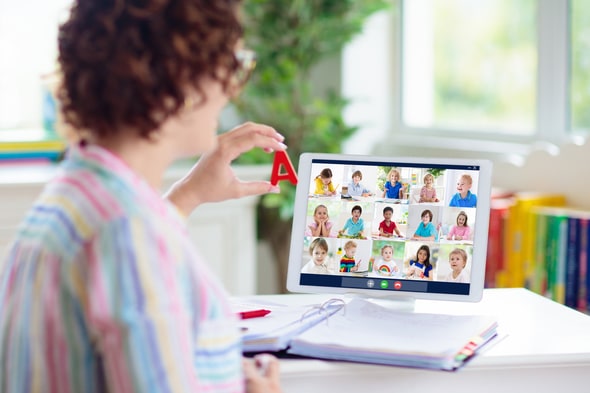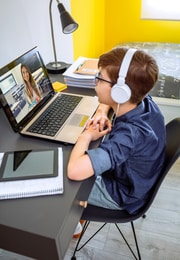How to Help Children Focus During Online Learning
Most schools have now reopened and many children are reaping the social and educational benefits of in-person learning. However, if your child thrived through online learning or is immunocompromised, it might be a good idea to keep them enrolled in a remote-learning school.
Additionally, school closures for things like snow days are now a thing of the past — teachers and students alike are well set up to offer online learning in lieu of physical classrooms.
If you’re a parent to a school-aged child, you simply must know how to help your child focus during online learning. Here are a few of the best practices to consider.
A Dedicated Space
Children may have a hard time separating their educational career from their personal life when learning at home. This is understandable, as we would all struggle to focus if our favorite toys or TV programs were just a few feet out of view. You can help children avoid distractions by creating a dedicated space that facilitates learning and engagement.
The space you choose for an at-home classroom will largely be dependent on the layout of your home. In general, though, your child will do best in a room where you can observe them, yet they feel as though they have privacy and are able to contribute to class discussions without worrying about being too loud.
The space you choose should also be completely free of clutter. Clutter is a major distraction for kids during classes they don’t enjoy, and can even pose a health hazard to younger children. You can declutter your home by intentionally organizing everything you own, and giving everything its own place. You should also try giving your child a home-desk, where they can store all their learning materials.
Fidgeting
Fidgeting is entirely normal behavior for children and adults alike. Some research even suggests that fidgeting and fidget toys can help children relax and focus during classes. However, as a parent, you probably have a good idea of when your child is fidgeting due to boredom or to distract themselves.
You can embrace productive fidgeting by providing your child with the kind of fidget toy or stimulus that suits their kind of fidgeting. For example, if they are body fidgeters, you can give them an exercise ball to sit on for part of the day, Alternatively, if you find that your child has a busy mouth, and likes to click or blow bubbles when they should be learning, you can give them caffeine-free tea to keep them occupied and well hydrated throughout the day.

Focus Throughout the Day
The hardest part about school is that children are expected to retain a high level of focus throughout the day. Unlike us adults, who are able to front-load more difficult work in the morning when we have more focus, children have to complete complex tasks in classes like math or literature regardless of the time of day or how they feel.
You can help your child retain their focus throughout the day by giving them brain breaks between classes or during their lunchtime. Ideally, these brain breaks will not involve screens and will get them up and moving. For example, a walk around the block, or even allowing them to help cook lunch will take their mind off learning, and help them return to the classroom with greater focus.
You also need to be aware of the food your child is eating, and how much water they are drinking. Typically, a school day diet should consist of whole foods with antioxidant-rich berries, protein sources, leafy greens, and plenty of water to keep them hydrated.
Testing for ADHD
Sometimes seeking help is the best thing you can do for your child. It doesn’t take much to have your child tested for ADHD, and the stigma around mental health conditions is finally being challenged and reversed in most areas of society.
According to the CDC, the symptoms of ADHD include inattention (difficulty organizing tasks, failure to pay close attention during classroom activities, forgetfulness during daily activities, etc.) and hyperactivity or impulsivity (fidgets or squirms in seat, talks excessively, interrupts conversations frequently).
The diagnosis of ADHD is typically made by your primary healthcare provider, who can then offer a range of treatment options that usually involve either behavioral and environmental changes or medication.
As a parent, it’s important to recognize that testing your child for ADHD does not mean you’ve “failed” them. You’re doing the right thing by reaching out to professional medical advice, and are showing your child that it’s ok to seek help when they need it.
Conclusion
Online learning can be great for children who struggle in traditional classrooms or aren’t able to return to a physical school environment.
However, maintaining a high level of focus throughout the day can be difficult — particularly if your home environment isn’t conducive to learning. You can help your child focus during remote classes by removing distractions from their at-home classroom, and by decluttering their space regularly. You should also reconsider the food you give them, and opt for focus-friendly whole foods that help them stay on track and engaged in their learning experience.
About the Author
 Katie Brenneman is a passionate writer specializing in education, mental health, family lifestyle and online safety. When she isn’t writing, you can find her with her nose buried in a book or hiking with her dog, Charlie. You can follow her on Twitter.
Katie Brenneman is a passionate writer specializing in education, mental health, family lifestyle and online safety. When she isn’t writing, you can find her with her nose buried in a book or hiking with her dog, Charlie. You can follow her on Twitter.
Teachers: Discover online class productivity tips to help keep kids engaged.




